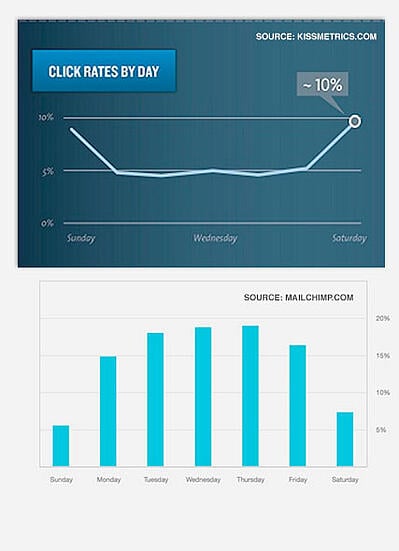Nearly a quarter of all marketing emails are viewed within 60 minutes of their arrival in recipients’ inboxes, according to an extensive study by GetResponse.
What? Don’t people go through all of the unread messages waiting for them every time they open their email? Apparently not. Email might not have the same “see it in your feed now or it’s gone” timely fickleness as a tweet, for example, but GetResponse’s data sends a clear message to marketers: Make sure to send emails when they’re most likely to be viewed, or your engagement rates will suffer.
It’s time to start thinking strategically about send timings.
Tweak, measure, repeat
 The GetResponse study came to some interesting findings regarding optimal email send timings, but research by others draws different conclusions.
The GetResponse study came to some interesting findings regarding optimal email send timings, but research by others draws different conclusions.
For example, KissMetrics found that the most emails are opened on the weekends, while MailChimp found that most emails are opened during the week. So whom are we to believe? No one.
Good marketers won’t take anything for granted, simply because they recognize that every brand is different, and every audience is different. Don’t even listen to what your gut tells you. Instead, make sure to create a system that allows you to experiment methodically, using a feedback loop. Create a spreadsheet with different send timings and the engagement results for each.
If your email list is several thousand strong, then you’re in great position to take this experiment even further - take other factors like email content and email subject lines out of the picture altogether and send the exact same email to random segments of your entire audience list at different time slots to see which one performs best.
Buck the trends
Sometimes departing from convention can help you to stand out. If everyone else sends marketing emails on weekday mornings, then you might do well to try weekend nights. There will be less competition for attention in the inbox.
Inbound marketing works best when your message differentiates you, effectively building the case why your audience should do business with you as opposed to anyone else. Making bold moves so you can stand out from the crowd is what it’s all about. And email send timing can be one of the ways you do that - especially if you can somehow thematically connect the timing to the email content or your branding.
Reference your buyer personas
Creating and refining fictional specific audience members is already part of your ongoing workflow, right? As opposed to market segment demographic data, which is more useful for selecting ad placements to buy, personas are extremely helpful when it comes to formulating marketing messages.
The best personas include all kinds of information about prototypical audience members, some based on data collected and some completely made up. You know - their favorite cars, blogs, shoes, movies and foods.
As you get to know these “people” and what makes them tick, you get a feel for their lifestyles. When and how do they use email? Do they look at their inboxes while riding the train to work at 8:00 AM and that’s it? Are they perpetually connected? Do they hate it when people try to talk business after hours? Are they looking for a laugh while their babies nap in the afternoons?
Good buyer personas make email scheduling easier.
Different timings for different emails
As convincing as huge data sets can be, optimized email timing should come down to the specifics of your message and its audience. Skilled inbound marketers will use email to keep people engaging with brands, and content for reading is just the beginning. Get to know the merits of transactional emails, auto-responders, drip campaigns and more.
With the powerful tools at our fingertips today, email scheduling can and should be handled in a way that matches the message. Some need to go out instantly, triggered by users taking action. Others may work best as follow-ups, weeks later. Or you could just go with Tuesdays at 10:00 AM.
Jason Thomas has been helping launch and develop start ups for 10 years. Jason's passion is working with motivated entrepreneurs to validate and implement ideas that grow their business.
Jason is a husband, father, and homesteader in training. In his spare time he's generally outside working with his hands and getting dirty.